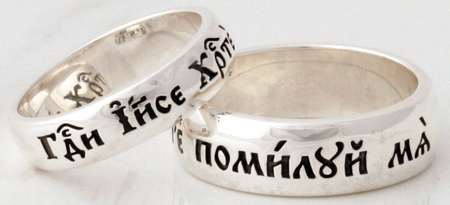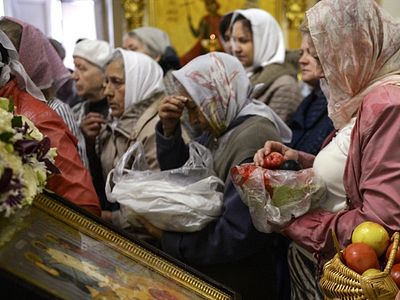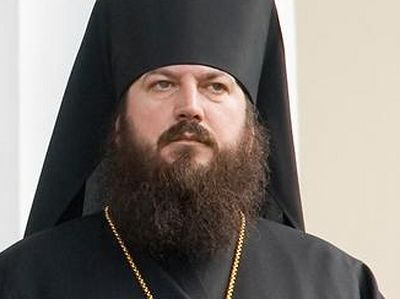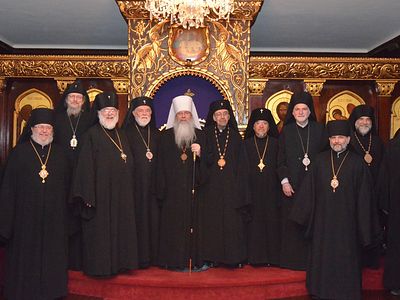On October 7/20 the Orthodox Church keeps the memory of the saints Sergius and Bacchus, known for their great friendship, who held high positions in the Roman army under the emperor Maximian (284-305) and were eventually martyred for their refusal to renonce Christ and worship the false pagan gods.
Unfortunately the memory of these illustrious saints is often perverted and blasphemed today by those who seek to force their own agenda upon the Church. In 1994 Yale professor John Boswell published the book "Same-Sex Unions in Premodern Europe" in which he argued that the Byzantine rite of adelphopoiesis, which mentions the martyrs Sergius and Bacchus, was in fact a Church-sanctioned service of homosexual marriage which the saints had undergone, and he even used an icon of Sts. Sergius and Bacchus on the cover of his book. Although his research has been debunked time and again, his argument is repeatedly resurrected by those seeking to introduce homosexual marriages into the Church.
Fr. Patrick Viscuso is a priest and canonist of the Greek Orthodox Archdiocese in America who has written numerous scholarly articles in the area of Byzantine marriage and canon law. In this present article, "Failed Attempt to Rewrite History," Fr. Viscuso defends the truth of historical Orthodox practice against the claims of Boswell, and in doing so honors the memory of Sts. Sergius and Bacchus.
* * *

Writing the history of a religious institution involves understanding concepts and language within their historical and cultural context. Yale professor John Boswell's book purports to find precedents for homosexual marriage, particularly in Eastern Orthodoxy during the late Byzantine period. His main contention is that the Byzantines regarded the rite of adelphopoiesis, a Greek term translated as "same-sex union" by Boswell, as a form of marriage contracted between two males and blessed by the Church.
It is beyond dispute that there are rites for adelphopoiesis contained in Byzantine manuscripts dating from the ninth to the 15th century. The ceremony was conducted by a priest for two males in church, and contained symbols common to Byzantine marriage rites including holding candles, joining hands, receiving Communion, and processing three times around a table used in the celebration. Prayers used for the sacerdotal blessing referred to God establishing "spiritual brothers" (pneumatikous adelphous) and contained references to sainted pairs, including most notably SS Sergius and Bacchus, who were famous for their friendship. The order of the service varied, but appeared to possess a simple structure, usually including petitions followed by the central prayer(s) of benediction and a dismissal.
In order to evaluate whether this service was equivalent to a marriage ceremony, it is necessary to understand how marital unions were formed in late Byzantium, and then to compare the rites. Our concern in this analysis will not be to examine the content of the prayers involved in the rites, as has already been accomplished in several reviews of Boswell's work, but to focus on the context in which the rites were used and described in late Byzantine society.
In late Byzantium, marital union was established through a process involving several stages: engagement, marriage contract, betrothal, and crowning.
Simple engagements were civil contracts. They were a promise of future union by the heads of households acting for their preadolescent children. They were not regarded as having any ecclesiastical significance and could be dissolved merely with the civil penalties related to breaking a legal agreement.
Marriage contracts also were a civil arrangement, most probably the "cross bonds" discussed by the 15th-century St. Symeon of Thessalonica. These consisted of agreements made before a representative of the state prior to the church ceremonies. During these arrangements, the spouses each agreed to a written marriage contract by signing a cross. The consent of the families to the union was expressed when the fathers of the future spouses touched the pens used by their children during the signing. The contracts signified the agreement of the couple and their families to the union, as well as the transfer of property into the marital community — e.g., the dowry of the bride and the ante-nuptial gift of the bridegroom. The contract signing was a purely civil form of marriage.
In contrast, formal betrothal involved a priestly blessing described in Byzantine sources as a "benediction." The main purpose of this blessing was the invocation of God in order that the betrothal might be confirmed and made indissoluble. However, if betrothals were broken, a Church divorce procedure was undertaken on the basis of stipulated grounds. After betrothal, the spouses were required to exhibit fidelity, but could not enjoy the positive rights of marriage, such as nuptial relations. The effects of betrothal on relations of kinship were similar to those of complete marriage.
The distinction of betrothal from complete marriage, which was established by the final rite of crowning, may be understood if the grounds for their dissolution are compared. While the grounds for divorce of a completed marriage concentrated on the disruption of marital union and dealt with adultery or situations that concerned actual or suspected sexual immorality, the causes for dissolving betrothals had a different focus, namely, finances, character, position in life, and events surrounding the contracting of the marriage. The difference indicated that while divorce in the case of a completed marriage was concerned with the loss of union, the sundering of betrothal dealt with the loss of the foundation for the union. Betrothal is a step in the completion of matrimony, nearly equivalent to marriage, but it is not the same as the completed union.
Crowning, the final stage of the formation of marriage, was named after the central rite of benediction during which crowns were placed on the heads of the bride and groom by the priest. As in the case of betrothal, a solemn invocation of divine blessing was made to establish the marital union. The marital union resulted in a number of kinships by marriage, known as relationships by affinity. Complex rules or canons governed whether such family members were allowed to intermarry. Once established, this type of kinship even survived the death of either or both of the spouses. These relationships were more extensive than those formed through any other Sacrament or mystery, including Baptism, which also resulted in certain prohibitions on marriage between the sponsor's family and the baptized.
If Byzantine marriage is compared with the rite for adelphopoiesis (what Boswell calls "same-sex union"), several differences are apparent. The first is that marriage occurs through a process, not a single rite. The most immediate reason for this appears to be that marital unity in Byzantine society involved both the spouses and their families, rather than simply individuals. The consent of the families was required at almost every stage of marriage formation. This is not to say that consent of the spouses was not required. The civil ceremony was the vehicle where matrimonial consent was manifested. This consent was also implied by the couple's mutual participation in the rites of betrothal and crowning, where the sacerdotal blessing established the union, and the priest was regarded as the minister of the Sacrament. In contrast, adelphopoiesis was not established by a process of gradual union between spouses and families, but rather was a union of two individuals. The resulting family kinships and marriage impediments were limited. Boswell cites the 11th-century jurist Eustathios Rhomaios, as stating: "same-sex unions are of persons, and they [the persons joined through the unions] alone incur impediments to marriage, but not the other members of their families." If "same-sex unions" were a form of matrimony, why would marriage impediments be an issue for those already united? It doesn't make sense. Even if it were allowed that such impediments were applicable when "same-sex unions" dissolved, such limited kinships and impediments are completely inconsistent with marriage as practiced within the context of late Byzantine society. Moreover, there appear to be no provisions in the Church, where Boswell claims homosexual marriages were blessed, for grounds of divorce. Certainly, if two men were married by the Church, would not there have been provisions for their separation, as was the case for all other forms of matrimony?
Adelphopoiesis established a different type of union from marriage, one perhaps closer to adoption. This view is supported by the fact that discussion of adelphopoiesis occurs in late Byzantine sources in connection with kinships established by adoption, contrary to the assertions of Boswell. In the context of these sources, the more literal translation of adelphopoiesis, "adopting a brother" or "brother adoption," appears to be more consistent with the ideas being expressed in the texts. For example, the 14th-century monk Matthew Blastares inThe Alphabetical Collection, an encyclopedia of canon law, discusses adelphopoiesis in the context of adoption, which in turn he relates to the general subject of kinship, not marriage. Boswell misses the context.
In his treatment of the 10th-century Typikon of John Tzimiskes, Boswell makes this translation: "it is not permitted to any of the brothers to leave the mountain to form relationships or unions [sunteknias e adelphopoiesis] with laypersons, and if any should happen to have done something like this...they may not go to their homes or breakfast with them...." The word sunteknia expressed the spiritual relationship established between the sponsor and godchild at Baptism. However, by translating the word as "relationship," Boswell changes the context for adelphopoiesis. A more proper translation might be "spiritual parenthood." Consequently, the parallel to this prohibition appears to be related to Baptism, another type of union establishing kinship ties, not to those rules "against monks marrying women," as Boswell asserts.
A similar problem occurs when the statement is made, "Harmenopoulos, a 14th-century jurist, in his commentary on a ruling by the seventh-century council in Trullo...quoted Peter, the chartophylax...as adding the comment that monks must not select boys at baptism and make same-sex unions with them." Nevertheless, when carefully examined, the passage in question is not dealing with the selection of boys, implying carnal relations, but rather with the prohibition of three types of relationships. The text of Harmenopoulos reads as follows, "It is unacceptable, he [Peter] states, for monks to receive children from holy baptism, to hold crowns of marriage, and to make brother adoptions." Two of these are clearly spiritual, sponsorship at Baptism and weddings, implying perhaps that the third, adelphopoiesis, shares a similar nature. In this context, the words, "receive children from holy baptism," refer to the role of the sponsor at the Baptism rite, who literally received the newly baptized child from the hands of the priest after the infant's threefold immersion in the font.
These problems of interpretation are not uncommon in Boswell's work and serve to distort the meaning of adelphopoiesis, which appears, from the passages cited, more related to adoption and the spiritual relationship associated with Baptism than with marriage, and which does not imply any sexual dimension.
Writing the history of a religious institution involves understanding concepts and language within their historical and cultural context. Otherwise, the risk is taken that history will be rewritten to suit current preoccupations. Boswell's attempt to prove that the Byzantines regarded adelphopoiesis as a form of marriage fails because his research presents historical facts and events out of context. From Boswell's viewpoint, it would appear that matrimony is being celebrated when two individuals are united by a priestly blessing in a service using symbols held in common with marriage ceremonies. However, Byzantine marriage was celebrated as a process that united families as well as spouses in a series of rituals, not in one rite that mainly affected its participants. Simply put, adelphopoiesis was certainly a kind of union between two individuals, but to make this institution equivalent to matrimony necessitates a perspective and context foreign to the late Byzantine Church.





